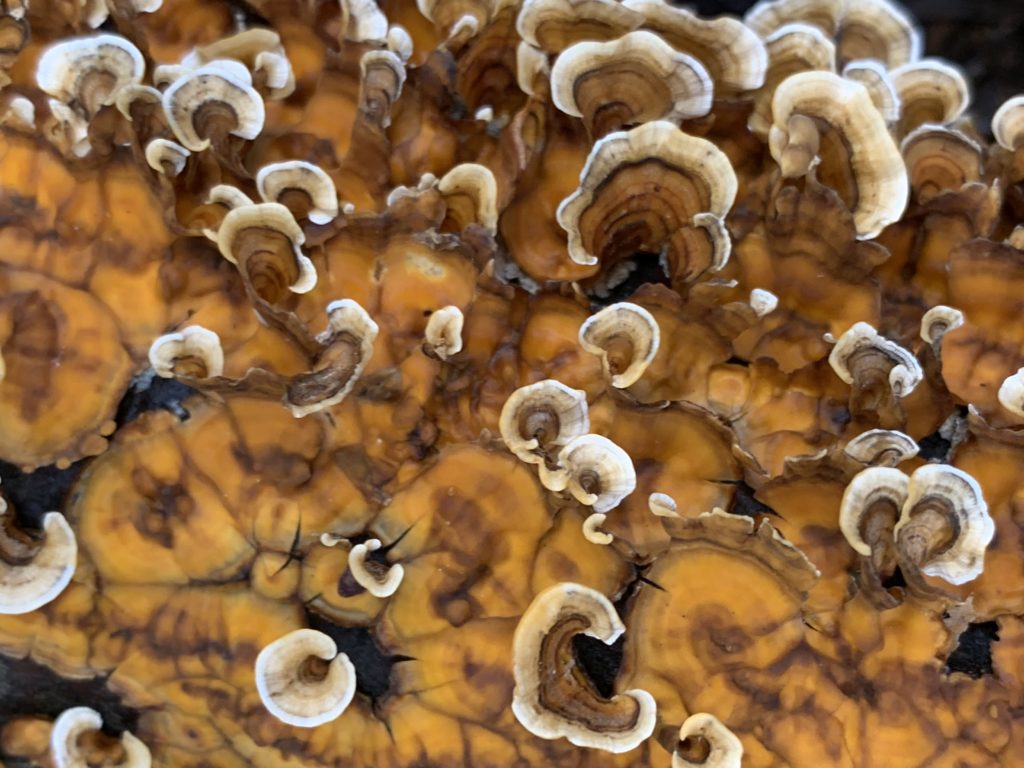It’s been a long, cold winter. To keep the winter blues at bay, we started planning our new garden space at the Forest House. It’s taken us a little bit to decide how to best utilize the almost 2 acre yard, but we finally have a Phase 1 plan in place. Similar to our garden at the Palms House, we will grow veggies and herbs. However, this time, we are also growing mushrooms!

Photo Courtesy of Dominik18s, CC by 2.0
DIY Backyard Mushrooms
We frequently purchase mushrooms at the local farmer’s market, and we know that many varieties grow well in our regional climate (7b/8a). So, why not grow mushrooms that we love to eat in our own backyard – for way less money? Growing gourmet mushrooms can be an easy and low maintenance DIY project put together over a few weekends. Plus, it’s a great project to do with the family. The kids may actually learn something in between all the grumbling! I’m just happy to get them outside and away from screens.
Growing on Logs
Though there are many methods and kits you can buy online, one of the easiest ways to grow backyard mushrooms is to use logs. Similar to how they grow in nature, many cultivated mushrooms grow on cut hardwood. It’s a pretty unfussy process and well suited to casual growers.
We’d already planned to clear some space for a muscadine vineyard (revisit our old vineyard from the Palms house here) in our backyard (more on that next week!), so we decided to use these freshly-cut logs to cultivate mushrooms.

We cut the trees this past weekend, but the logs need to sit off the ground for at least 2 weeks. We placed a few pieces of pressure-treated wood underneath them to keep them slightly lifted off the ground. This ‘sit time’ allows for any naturally occurring anti-fungal properties in the wood to dissipate. Without sitting for a little bit, the wood could kill off the mycelium (networks of fungal “roots”) and prevent growth the fruiting bodies (the edible parts).
Starting the Process
Growing mushrooms on logs is pretty straightforward. For this initial phase, you will:
- Harvest enough logs to stack a few rows high (3-4 ft. lengths and 3-4 inches in diameter)
- Allow the logs to rest 2 weeks without touching the ground
- Order your mushroom supplies while you wait (more on that below)

Order Your Mushroom Spawn
After the logs have been cut, it’s time to order the mushroom spawn (we ordered from Fungi Perfecti). The Mushroom Plug Spawn are essentially little wooden doles inoculated with mushroom mycelium. Once the logs are ready to be inoculated, we will drill holes in the logs (great job for teenagers) and then tap the plugs into the holes with a rubber mallet. After the plugs are placed, we will seal the holes with wax (great job for younger kids) to keep out other fungi or bacteria trying to compete for the log. I’ll post more about this process (with photos) in Part II.
My Order:
- Maitake Plug Spawn – 100 Plugs × 1 = $9.87
- Lion’s Mane Plug Spawn – 100 Plugs × 1 = $9.87
- Reishi Plug Spawn – 100 Plugs × 1 = $9.87
- Shiitake Plug Spawn – 100 Plugs × 2 = $19.73
- Blue Oyster Plug Spawn – 100 Plugs × 1 = $9.87
- The Garden Giant Mushroom Patch™ × 1 = $25.00 (ones for the garden!)
- Sealing Wax for Plug Spawn × 2 (1 lb.) = $9.90
Total $124.12 USD including tax & shipping
Considering that what we purchase at the farmer’s market typically costs around $5-8/lb, we figure we will recoup our investment in the first couple of harvests (aka – in a few months)!
Sustainable Permaculture
This permaculture project will provide you and your family with a healthy, inexpensive food source (if you love tasty mushrooms as much as we do), and will add value to your property. Once you get a mushroom log-stack established, you can just sit back and watch them grow. You’ll be collecting pounds and pounds of your own high-quality, organic mushrooms for 5 to 10 years.
If you’re interested in a mushroom hobby, or just find them interesting, check out Fungi.com, the site run by Paul Stamets, an expert mycologist and author. After reading his book Mycelium Running, I’ve developed an appreciation for mushrooms, especially the many benefits they can provide the human body. Now, I’m constantly snapping pictures (below) of wild mushrooms I find while out walking the dogs.
We think it’s fun to create interesting “destinations” within your home and throughout your outdoor spaces. These can be comfortable seating areas, fire pit/barbecuing areas, gardens, flower beds, or, in this case, something a little out-of-the-ordinary: growing mushrooms!
Growing Mushrooms Phase II coming in two weeks!












Love it!